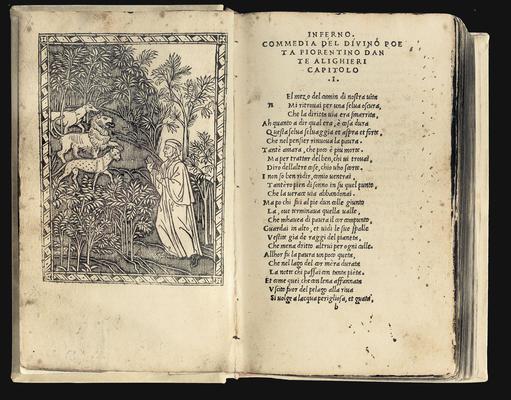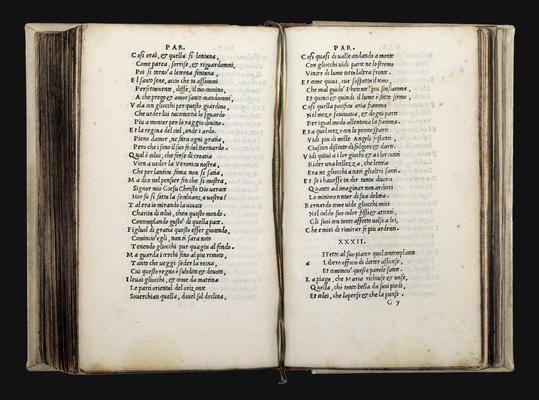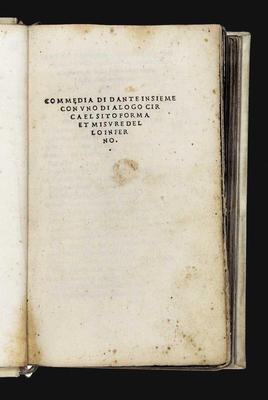Dante Alighieri
Commedia di Dante insieme con uno dialogo circa el sito forma et misure dello Inferno.
Florence, Filippo Giunta, 20 August 1506 .8° (167x99 mm). Collation: a6, b-z8, &8, A-F8, G10, H-P8. [312] leaves. Complete, including the bifolium signed Gy inserted in the middle of the eight-leaf quire G, often lacking. Italic and roman type. Blank spaces for capitals, with printed guide letters. Eight woodcuts, the first one depicting Dante and the three wild beasts (fol. a6v), the other ones showing cross-sections and maps of Hell (fols. L2r, O5r, O6r, O7r, O7v, O8v), and a map of the Earth, with the position of Hell and Purgatory (fol. O4r). Nineteenth-century vellum, over pasteboards. Smooth spine, divided in compartments by gilt fillets. Title and imprint on double lettering-pieces. Multicolour silk bookmark, blue edges. A very fine wide-margined copy, slight spotting and foxing. A short tear at fol. O2 repaired, without any loss. On the verso of the front flyleaf an early shelfmark ‘B.7.40'.
Provenance: Livio Ambrogio collection.
The first edition of the Commedia from the Florentine press of Filippo Giunta, printed – like the Aldine of 1502 – in octavo format and in italic type, containing the first topographical woodcuts of Hell, which for Dante was a real place, shaped in the form of a funnel and situated underneath the city of Jerusalem. The text was edited by the Florentine humanist Girolamo Benivieni (1453-1542), introduced by the Cantico in laude di Dante, composed by Benivieni himself in imitation of a Dantean canto. The ‘Giuntina' – the second Florentine edition of the Commedia, following the 1481 Landino edition – represents a veritable milestone in the printing of Dante's poem for its inclusion, in an appendix, of the Dialogocirca el sito, forma et misure dello Inferno di Dante Alighieri by the Florentine mathematician, architect, and member of the Accademia Fiorentina Antonio di Tuccio Manetti (1423-1497), posthumously edited from Manetti's notes by Benivieni, and presenting for the first time in the iconographical tradition of the Commedia woodcut cross-sections and maps of Hell. The images illustrating the position, structure, and dimensions of Hell are based on Manetti's unpublished calculations and designs, which had been one of the sources employed – in addition to Nardo di Cione's fresco in Santa Maria Novella in Florence – by Sandro Botticelli for his famous La Mappa dell'Inferno (Biblioteca Vaticana,msVat. Lat. 1896). A synopsis of Manetti's calculations had already been included by Landino in his commentary to the Commedia of 1481, but only after the 1506 Giuntina did the vogue for measuring and mapping Hell become widespread. During the sixteenth century much theological and scientific debate focused on the cartography of Hell; the young Galileo Galilei lectured on this topic in 1587-1588 to the Florentine Academy.
The present copy includes the bifolium signed Gy, inserted by Giunta during the printing of the quire G owing to a mistake made by the compositor, and containing the verses 121-142 from Cantoxxxiof the Paradiso, and the verse 1-96 from Cantoxxxii. These extra leaves are often lacking in the recorded copies.




